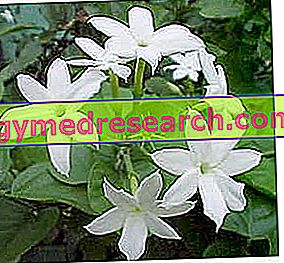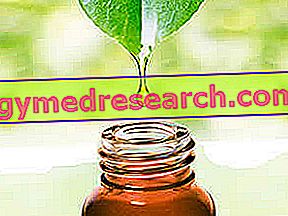Jasmine in history
Jasmine is a evergreen climbing vine or shrub, originating in China, western Asia and northern India. From the reading of some sources, jasmine seems to have been imported into Europe around 1500, by the Spaniards; however, some authors are perplexed about this, since the ancient findings concerning the "Liber de Simplicibus" Code shift the date of import to the previous century, considering the depiction of jasmine in this text dating back to 1415.

Analysis of the term
The flower is also known as white jasmine, common jasmine, jasmine of poets or, again, jasmine or jessamine . The name "jasmine" seems to have Persian origin ( yasamin ): with time, at the original term yasamin the word mulberry overlapped, giving rise to the current name recognized to the flower. In botany, jasmine is Jasminum officinale and, when it refers to the pendula variety, J. grandiflorum (among the most common species we remember the jasmine of Catalonia and that of Spain).
Botanical analysis
Jasmine belongs to the Oleaceae family, the same as ash, olive and privet: it is an evergreen plant characterized by opposite leaves - each formed by 5-7 leaflets - and by small fragrant white flowers. Not surprisingly, the cosmetics and perfume industry extracts the essential oil of jasmine for the formulation of perfumed creams and essences.
Jasmine has a typical climbing pattern, with thin and fragile stems; the plant flowers in the warm months, particularly from July to September. However, jasmine is a "strong" plant because it can withstand even very cold temperatures, even below zero; in fact, despite the frost can destroy the branches of jasmine, the roots are unlikely to suffer heavily.
Jasmine essential oil
As we have seen, jasmine is very cultivated also for its essence, very fragrant and refined: the essential oil is extracted from the petals, which preserve the essence inside some epidermal sacs placed in the inner face of the flower itself. [from A. Bruni's Dictionary of herbal medicine and phytotherapy ]
Among the main constituents, we mention: linalyl acetate, linalool, benzoyl acetate, phenylacetic acid, farnesol and, especially jasmone, a ketone characterizing the extract and responsible for the typical fragrance. [from the Encyclopedia of Essential Oils, by J. Lawless]
The chemical components are extracted by steam distillation or enfleurage.
Herbal uses
Jasmine is also used in the herbalist-phytotherapeutic field for its antispasmodic and antirheumatic properties: for these purposes, the Gelsemium nitidum variety, typical of the Americas, is considered in particular.
The bath salts with the essence of jasmine are used as a mild sedative and relaxing: not surprisingly, chemical compounds act in the brain and psychic level, bringing back a firm and relaxed character.
Jasmine is also used against diseases affecting the respiratory system, such as cough, hoarseness, phlegm and mild laryngitis.
For internal use, it is also recommended in cases of menstrual pain and uterine pain in general.
It seems that jasmine is able to induce optimism and euphoria: in this regard, it is used to counteract depressive states and irritability.
In folk medicine, it is said that the power of jasmine is such as to eradicate envy and jealousy from the people who suffer from it; still, according to tradition, jasmine would help to take responsibility and become aware of how one acts and behaves.
Homeopathy
Jasmine is also used for homeopathic purposes: the mother tincture obtained from the roots of the flower seems to act positively in the case of myasthenia, insomnia, migraine, memory loss and, again, cold and localized motor paralysis. [from A. Bruni's Dictionary of herbal medicine and phytotherapy ]
Cosmetics
Thanks to the particular and unmistakable scent of jasmine, intense but at the same time delicate, cosmetics wisely uses its essence to make perfumes, perfumed waters, lotions and creams. The most serious problem is represented by the cost: to obtain 1 kg of essence 8, 000 flowers must be used. To avoid weighing on the price of the finished product, synthetic products are often used which imitate - albeit perfectly - the essential oil of jasmine.
Tradition and legends
According to an Arab belief, paradise is permeated with jasmine flowers: not surprisingly, the flower is often used as a symbol of divine love.
In ancient times, jasmine symbolized immortality, while in Spain it has always been considered a symbol of sensuality.
The white color of jasmine flowers indicates affection and love, red indicates desire, while yellow indicates happiness.
Summary
Jasmine: to fix the concepts ...
| Jasmine: description and origin | Tendril or climbing evergreen shrub, originating in China, western Asia and northern India |
| Jasmine: age of importation into Europe | Hypothesis N ° 1: jasmine was imported by the Spaniards around 1500 Hypothesis N ° 2: jasmine has been present in Europe since 1400 (figure of the flower impressed in the Liber de Simplicibus Code) |
| Jasmine: cultivation goals | Jasmine is grown for ornamental, phytotherapeutic, homeopathic, cosmetic and even food purposes |
| Jasmine: analysis of the term and etymology |
|
| Jasmine: botanical analysis |
|
| Jasmine and essential oil | Very fragrant and refined essence, made from: linalyl acetate, linalool, benzoyl acetate, phenylacetic acid, farnesol and, above all, jasmone |
| Jasmine: extraction of essential oils | Steam current distillation enfleurage |
| Jasmine and herbal uses |
|
| Jasmine in the tradition |
|
| Jasmine and homeopathy | Mother tincture obtained from the roots of the flower: useful in case of myasthenia, insomnia, migraine, memory loss, cold and localized motor paralysis |
| Jasmine and cosmetics | Particular and unmistakable scent of jasmine → cleverly used by cosmetics to create creams, lotions, perfumed waters and perfumes |
| Jasmine, tradition and legends |
|



